Answered step by step
Verified Expert Solution
Question
1 Approved Answer
Can you answer these questions? Thank you 42 The AICPA's Code of Professional Conduct states that a CPA should maintain integrity and objectivity. The term

Can you answer these questions? Thank you
42 The AICPA's Code of Professional Conduct states that a CPA should maintain integrity and objectivity. The term objectivity in the Code refers to a CPA's ability to: a. choose independently between alternate accounting principles and auditing standards. b. distinguish between accounting practices that are acceptable and those that are not. be unyielding in all matters dealing with auditing procedures. d. maintain an impartial attitude on matters that come under the CPA's review. 43. Which of the following statements is true when the CPA has been engaged to perform an audit of financial statements? a. The CPA firm is engaged and paid by the client; therefore, the firm has primary responsibility to be an advocate for the client. b. The CPA firm is engaged and paid by the client, but the primary beneficiaries of the audit are those who rely on the financial statements. Should a situation arise where there is no convincing authoritative standard available, and there is a choice of actions which could impact a client's financial statements, the CPA is free to endorse the choice which is in the investors' interests. d. The CPA firm has primary responsibility to the FASB. 44. Soo The four parts to the AICPA's Code of Professional Conduct are:. a. Principles, GAAS, Interpretations, Ethical Rulings General Standards, Rules of Conduct, Interpretations, Ethical Rulings Principles, Rules of Conduct, Interpretations, Ethical Rulings Principles, Rules of Conduct, Interpretations, Enforceable Decisions 45. The standard of due care to which the auditor is expected to adhere is referred to as the: a. prudent person concept. b. common law doctrine. due care concept. d. vigilant person concept. ooo 46. Failure of a party to meet its obligations, thereby causing injury to another party to whom a duty was owed, is: a. breach of contract. b. tort action for negligence. constructive fraud. d. fraud. sooStep by Step Solution
There are 3 Steps involved in it
Step: 1

Get Instant Access to Expert-Tailored Solutions
See step-by-step solutions with expert insights and AI powered tools for academic success
Step: 2

Step: 3

Ace Your Homework with AI
Get the answers you need in no time with our AI-driven, step-by-step assistance
Get Started


